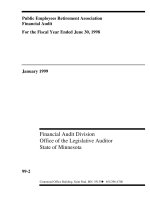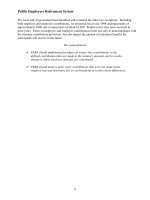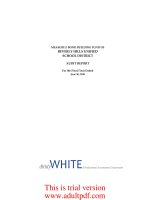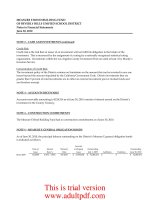REPORT NO. 2011-039 NOVEMBER 2010 BROWARD COLLEGE Financial Audit For the Fiscal Year Ended June 30, 2010_part4 pdf
Bạn đang xem bản rút gọn của tài liệu. Xem và tải ngay bản đầy đủ của tài liệu tại đây (240.7 KB, 8 trang )
NOVEMBER 2010 REPORT NO. 2011-039
BROWARD COLLEGE
A COMPONENT UNIT OF THE STATE OF FLORIDA
NOTES TO FINANCIAL STATEMENTS (C
ONTINUED)
J
UNE 30, 2010
30
defined-benefit pension plan (Plan), a Deferred Retirement Option Program (DROP), and a
defined-contribution plan, referred to as the Public Employee Optional Retirement Program (PEORP).
Employees in the Plan vest at six years of service. All vested members are eligible for normal retirement
benefits at age 62 or at any age after 30 years of service, which may include up to 4 years of credit for
military service. The Plan also includes an early retirement provision; however, there is a benefit reduction
for each year a member retires before his or her normal retirement date. The Plan provides retirement,
disability and death benefits, and annual cost-of-living adjustments.
DROP, subject to provisions of Section 121.091, Florida Statutes, permits employees eligible for normal
retirement under the Plan to defer receipt of monthly benefit payments while continuing employment with
an FRS employer. An employee may participate in DROP for a period not to exceed 60 months after
electing to participate. During the period of DROP participation, deferred monthly benefits are held in the
FRS Trust Fund and accrue interest.
The State of Florida establishes contribution rates for participating employers. Contribution rates during the
2009-10 fiscal year were as follows:
Class Percent of Gross Salary
Employee Employer
(A)
Florida Retirement System, Regular 0.00 9.85
Florida Retirement System, Senior Management Service 0.00 13.12
Deferred Retirement Option Program - Applicable to
Members from All of the Above Classes 0.00 10.91
Florida Retirement System, Reemployed Retiree (B) (B)
Notes: (A)
(B)
Employer rates include 1.11 percent for the postemployment health
insurance subsidy. Also, employer rates, other than for DROP
participants, include 0.05 percent for administrative costs of the Public
Employee Optional Retirement Program.
Contribution rates are dependent upon retirement class in which
reemployed.
The College’s liability for participation is limited to the payment of the required contribution at the rates and
frequencies established by law on future payrolls of the College. The College’s contributions for the fiscal
years ended June 30, 2008, June 30, 2009, and June 30, 2010, totaled $5,122,526, $5,256,544, and $5,442,853,
respectively, which were equal to the required contributions for each fiscal year.
As provided in Section 121.4501, Florida Statutes, eligible FRS members may elect to participate in the
PEORP in lieu of the FRS defined-benefit plan. College employees already participating in the State College
System Optional Retirement Program or the DROP are not eligible to participate in this program.
Employer contributions are defined by law, but the ultimate benefit depends in part on the performance of
investment funds. The PEORP is funded by employer contributions that are based on salary and
membership class (Regular Class, Senior Management Service Class, etc.). Contributions are directed to
individual member accounts, and the individual members allocate contributions and account balances among
This is trial version
www.adultpdf.com
NOVEMBER 2010 REPORT NO. 2011-039
BROWARD COLLEGE
A COMPONENT UNIT OF THE STATE OF FLORIDA
NOTES TO FINANCIAL STATEMENTS (C
ONTINUED)
J
UNE 30, 2010
31
various approved investment choices. Employees in PEORP vest at one year of service. There were
222 College participants during the 2009-10 fiscal year. Required contributions made to the PEORP totaled
$1,061,157.
Financial statements and other supplementary information of the FRS are included in the State’s
Comprehensive Annual Financial Report, which is available from the Florida Department of Financial
Services. An annual report on the FRS, which includes its financial statements, required supplementary
information, actuarial report, and other relevant information, is available from the Florida Department of
Management Services, Division of Retirement.
State College System Optional Retirement Program
. Section 1012.875, Florida Statutes, provides for an
Optional Retirement Program (Program) for eligible college instructors and administrators. The Program is
designed to aid colleges in recruiting employees by offering more portability to employees not expected to
remain in the FRS for six or more years.
The Program is a defined-contribution plan, which provides full and immediate vesting of all contributions
submitted to the participating companies on behalf of the participant. Employees in eligible positions can
make an irrevocable election to participate in the Program, rather than the FRS, and purchase retirement and
death benefits through contracts provided by certain insurance carriers. The employing college contributes,
on behalf of the participant, 10.43 percent of the participant’s salary, less a small amount used to cover
administrative costs. The remaining contribution is invested in the company or companies selected by the
participant to create a fund for the purchase of annuities at retirement. The participant may contribute, by
payroll deduction, an amount not to exceed the percentage contributed by the college to the participant’s
annuity account.
There were 166 College participants during the 2009-10 fiscal year. Required employer contributions made
to the Program totaled $1,278,037.
14. CONSTRUCTION COMMITMENTS
The College’s major construction commitments at June 30, 2010, are as follows:
Project Description Total Completed Balance
Contract to Date Committed
Central Campus:
Institute of Public Safety Remodel 13,876,017$ 2,797,992$ 11,078,025$
South Campus:
Building 72 Renovations 9,489,959 1,324,799 8,165,160
Total
23,365,976$ 4,122,791$ 19,243,185$
15. RISK MANAGEMENT PROGRAMS
The College is exposed to various risks of loss related to torts; theft of, damage to, and destruction of assets;
errors and omissions; injuries to employees; and natural disasters. The College provided coverage for these
This is trial version
www.adultpdf.com
NOVEMBER 2010 REPORT NO. 2011-039
BROWARD COLLEGE
A COMPONENT UNIT OF THE STATE OF FLORIDA
NOTES TO FINANCIAL STATEMENTS (C
ONTINUED)
J
UNE 30, 2010
32
risks primarily through the Florida College System Risk Management Consortium (Consortium), which was
created under authority of Section 1001.64(27), Florida Statutes, by the boards of trustees of the Florida
public colleges for the purpose of joining a cooperative effort to develop, implement, and participate in a
coordinated Statewide College risk management program. The Consortium is self-sustaining through
member assessments (premiums) and is reinsured through commercial companies for claims in excess of
specified amounts. Reinsurance from commercial companies provided excess coverage of up to
$175 million through February 2010, then $150 million from March 2010. Insurance coverage obtained
through the Consortium included fire and extended property, general and automobile liability, workers’
compensation, and other liability coverage. Settled claims resulting from these risks have not exceeded
coverage in any of the past three fiscal years.
Life, dental, and long-term disability coverage are provided through purchased commercial insurance with
minimum deductibles for each line of coverage. Settled claims resulting from these risks have not exceeded
commercial coverage in any of the past three fiscal years.
Self-Insured Program
. The Board has established an individual self-insured program to provide group
health insurance for its employees, retirees, former employees, and their dependents. The College’s liability
was limited by excess reinsurance to $175,000 per insured person through December 2009, then $200,000
from January 2010. The plan is provided by an insurance company licensed by the Florida Department of
Financial Services, Office of Insurance Regulation. The College contributes employee premiums as a fringe
benefit. Employee dependent coverage is by payroll deduction and coverage for retirees, former employees,
and their dependents is by prepaid premium.
The College reports a liability when it is probable that a loss has occurred and the amount of that loss can be
reasonably estimated. The liability includes an amount for claims that have been incurred, but not reported,
and an amount for claims administration expense. Because the actual claims liability depends on such
complex factors as inflation, change in legal doctrines, and damage awards, the process used in computing
the claims liability does not necessarily result in an exact amount. The College reevaluates the claims liability
periodically and the claims liability totaled $10,019,389 as of June 30, 2010. Amounts held by the College in
excess of the estimated insurance claims liability at June 30, 2010, totaled $8,042,613 and are classified as
insurance claims deposits. The College will use these amounts to pay claims incurred in future fiscal years.
The following schedule represents the changes in claims liability for the past two fiscal years for the College’s
self-insured program:
Fiscal Beginning Claims and Claim End of
Year of Fiscal Changes in Payments Fiscal
Year Estimates Year
2008-09 $6,065,201 11,387,597$ 10,589,975$ 6,862,823$
2009-10 $9,036,940 (1) 12,840,734$ 11,858,285$ 10,019,389$
Note: (1) Beginning balance increased by $2,174,117 to correct prior period error.
This is trial version
www.adultpdf.com
NOVEMBER 2010 REPORT NO. 2011-039
BROWARD COLLEGE
A COMPONENT UNIT OF THE STATE OF FLORIDA
NOTES TO FINANCIAL STATEMENTS (C
ONTINUED)
J
UNE 30, 2010
33
Commercially Purchased Insurance
. In support of its aviation program, the College has purchased
Airport Premises and Aircraft Hull and Liability coverage through a commercial carrier with a minimum
deductible. Settled claims resulting from these risks have not exceeded commercial coverage in any of the
past three fiscal years.
16. SCHEDULE OF STATE REVENUE SOURCES
Revenue from State sources for current operations is primarily from the College Program Fund administered
by the Florida Department of Education under the provisions of Section 1011.81, Florida Statutes. In
accordance with Section 1011.84, Florida Statutes, the Legislature determines each college’s apportionment
considering the following components: base budget, which includes the State appropriation to the College
Program Fund in the current year plus the related student tuition and fees assigned in the current General
Appropriations Act; the cost-to-continue allocation, which consists of incremental changes to the base
budget, including salaries, price levels, and other related costs; enrollment workload adjustments; operation
costs of new facilities adjustments; and new and improved program enhancements, which are determined by
the Legislature. Student fees in the base budget plus student fee revenues generated by increases in fee rates
are deducted from the sum of these components to determine the net annual State apportionment to each
college.
The State allocates gross receipts taxes, generally known as Public Education Capital Outlay money, to the
College on an annual basis. The College is authorized to receive and expend these resources only upon
applying for and receiving an encumbrance authorization from the Florida Department of Education.
The following is a summary of State revenue sources and amounts:
Source Amount
College Program Fund 58,644,305$
Gross Receipts Tax (Public Education Capital Outlay) 8,536,943
8,268,508
Florida Student Assistance Grants 5,916,938
Bright Futures Scholarship Program 3,947,253
Restricted Contracts and Grants 2,275,274
Motor Vehicle License Tax (Capital Outlay and Debt Service) 1,133,200
Total
88,722,421$
Education Enhancement Trust Fund (Lottery)
17. FUNCTIONAL DISTRIBUTION OF OPERATING EXPENSES
The functional classification of an operating expense (instruction, academic support, etc.) is assigned to a
department based on the nature of the activity, which represents the material portion of the activity
attributable to the department. For example, activities of an academic department for which the primary
departmental function is instruction may include some activities other than direct instruction such as public
service. However, when the primary mission of the department consists of instructional program elements,
all expenses of the department are reported under the instruction classification. The operating expenses on
This is trial version
www.adultpdf.com
NOVEMBER 2010 REPORT NO. 2011-039
BROWARD COLLEGE
A COMPONENT UNIT OF THE STATE OF FLORIDA
NOTES TO FINANCIAL STATEMENTS (C
ONTINUED)
J
UNE 30, 2010
34
the statement of revenues, expenses, and changes in net assets are presented by natural classifications. The
following are those same expenses presented in functional classifications as recommended by NACUBO:
Functional Classification Amount
Instruction 72,063,427$
Public Services 1,209,914
Academic Support 18,771,326
Student Services 20,854,939
Institutional Support 26,103,438
Operation and Maintenance of Plant 28,597,054
Scholarships and Fellowships 37,622,148
Depreciation 8,542,300
Auxiliary Enterprises 17,950,275
Total Operating Expenses
231,714,821$
18. FISCAL AGENT FOR THE HIGHER EDUCATION TECHNOLOGY GROUP
Effective July 1, 2002, the College was elected fiscal agent for the Florida Community College Software
Consortium (FCCSC). During the 2009-10 fiscal year, FCCSC changed its name to Higher Education
Technology Group (HETGroup). As fiscal agent, the College is responsible for receiving, disbursing, and
administering all moneys due to or payable from the Consortium and for certain personnel functions. For
the 2009-10 fiscal year, HETGroup revenues and expenditures totaled $2,200,031 and $2,346,081,
respectively, and are reported as operating nongovernmental grants and contracts and operating
expenditures, respectively, on the statement of revenues, expenses, and changes in net assets. At
June 30, 2010, net assets of the Consortium totaling $1,760,649 are held in the College’s Current Restricted
Fund.
This is trial version
www.adultpdf.com
NOVEMBER 2010 REPORT NO. 2011-039
BROWARD COLLEGE
OTHER REQUIRED SUPPLEMENTARY INFORMATION
SCHEDULE OF FUNDING PROGRESS –
OTHER POSTEMPLOYMENT BENEFITS PLAN
35
Actuarial UAAL as a
Actuarial Accrued Unfunded Percentage
Actuarial Value of Liability (AAL) - AAL Funded Covered of Covered
Valuation Assets Entry Age (UAAL) Ratio Payroll Payroll
Date (a) (b) (b-a) (a/b) (c) [(b-a)/c]
10/1/2007 -$ 19,439,651$ 19,439,651$ 0% 61,198,715$ 31.8%
10/1/2009 -$ 18,692,337$ 18,692,337$ 0% 63,329,742$ 29.5%
This is trial version
www.adultpdf.com
NOVEMBER 2010 REPORT NO. 2011-039
36
AUDITOR GENERAL
STATE OF FLORIDA
G74 Claude Pepper Building
111 West Madison Street
Tallahassee, Florida 32399-1450
The President of the Senate, the Speaker of the
House of Representatives, and the
Legislative Auditing Committee
INDEPENDENT AUDITOR’S REPORT ON INTERNAL CONTROL OVER
FINANCIAL REPORTING AND ON COMPLIANCE AND OTHER MATTERS
BASED ON AN AUDIT OF THE FINANCIAL STATEMENTS PERFORMED
IN ACCORDANCE WITH
GOVERNMENT AUDITING STANDARDS
We have audited the financial statements of Broward College, a component unit of the State of Florida, and its
discretely presented component unit as of and for the fiscal year ended June 30, 2010, which collectively comprise the
College’s basic financial statements, and have issued our report thereon included under the heading
INDEPENDENT AUDITOR’S REPORT ON FINANCIAL STATEMENTS. Our report on the financial
statements was modified to include a reference to other auditors. We conducted our audit in accordance with auditing
standards generally accepted in the United States of America and the standards applicable to financial audits contained
in Government Auditing Standards issued by the Comptroller General of the United States. Other auditors audited the
financial statements of the discretely presented component unit as described in our report on the College’s financial
statements. This report does not include the results of the other auditors’ testing of internal control over financial
reporting or compliance and other matters that are reported on separately by those auditors.
Internal Control Over Financial Reporting
In planning and performing our audit, we considered the College’s internal control over financial reporting as a basis
for designing our auditing procedures for the purpose of expressing our opinion on the financial statements, but not
for the purpose of expressing an opinion on the effectiveness of the College’s internal control over financial reporting.
Accordingly, we do not express an opinion on the effectiveness of the College’s internal control over financial
reporting.
A deficiency in internal control exists when the design or operation of a control does not allow management or employees,
in the normal course of performing their assigned functions, to prevent or detect and correct misstatements on a
timely basis. A material weakness is a deficiency, or a combination of deficiencies, in internal control such that there is a
reasonable possibility that a material misstatement of the College’s financial statements will not be prevented, or
detected and corrected on a timely basis.
DAVID W. MARTIN, CP
A
AUDITOR GENERAL
PHONE: 850-488-5534
F
AX: 850-488-6975
This is trial version
www.adultpdf.com
NOVEMBER 2010 REPORT NO. 2011-039
37
Our consideration of internal control over financial reporting was for the limited purpose described in the first
paragraph of this section and was not designed to identify all deficiencies in internal control over financial reporting
that might be deficiencies, significant deficiencies, or material weaknesses. We did not identify any deficiencies in
internal control over financial reporting that we consider to be material weaknesses, as defined above.
Compliance and Other Matters
As part of obtaining reasonable assurance about whether the College’s financial statements are free of material
misstatement, we performed tests of its compliance with certain provisions of laws, rules, regulations, contracts, and
grant agreements, noncompliance with which could have a direct and material effect on the determination of financial
statement amounts. However, providing an opinion on compliance with those provisions was not an objective of our
audit, and accordingly, we do not express such an opinion. The results of our tests disclosed no instances of
noncompliance or other matters that are required to be reported under Government Auditing Standards.
Pursuant to Section 11.45(4), Florida Statutes, this report is a public record and its distribution is not limited.
Auditing standards generally accepted in the United States of America require us to indicate that this report is
intended solely for the information and use of the Legislative Auditing Committee, members of the Florida Senate
and the Florida House of Representatives, Federal and other granting agencies, and applicable management and is not
intended to be and should not be used by anyone other than these specified parties.
Respectfully submitted,
David W. Martin, CPA
November 19, 2010
This is trial version
www.adultpdf.com









